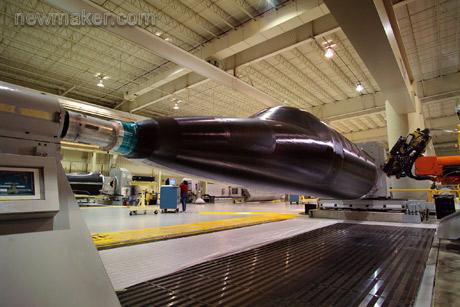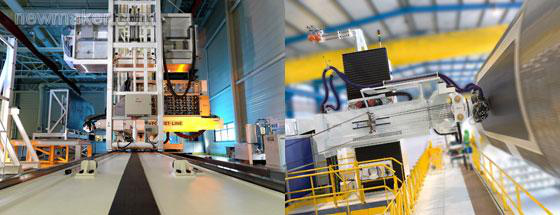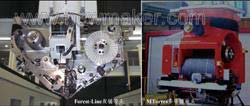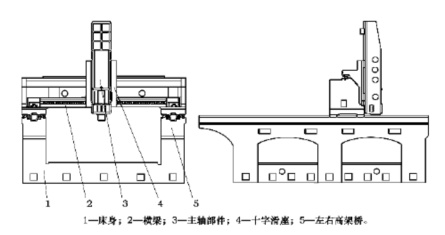The latest development of high end automatic tape laying machine/silk laying machine (ATL/AFP)
 192
192
Development of automatic tape laying machine/automatic silk laying machine ATL/AFP
Composites with high strength and low density have been widely used in the design and manufacture of modern large aircraft structures instead of traditional aluminum alloy, and have gradually become the main structural materials of modern large aircraft. For example, the composite material weight ratio of Boeing 787 dreamliner and Airbus A350 XWB wide-body aircraft has exceeded 50%. This trend is continuing and is forecast to reach 70-80% by 2015-2020. A number of innovative all-composite or quasi-all-composite fuselage components have been developed for unmanned aerial vehicles, helicopters and commercial aircraft, and the era of aircraft using composite as the main structural component has arrived.
In the mass production of modern large aircraft, ATL/ AFP, which is used for the manufacture of composite integral parts, has become the key equipment. Before the end of 1990s and the beginning of this century (2001), Cincinnati Machine Tool Company and Ingersoll Company could provide large ATL/AFP machine tools to the aviation and aircraft manufacturing industry. ADC (Automated Dynamics Corp.) can provide AFP machine tools. In the last 10 years, the urgent need for automated composite component manufacturing technology in the aviation and aircraft industry has driven the rapid development and wider industrial application of ATL/AFP machine tools. However, the number of manufacturers that can supply ATL/AFP machines to the aviation and aircraft industry is still very limited compared to the goldcut CNC machines.
In recent 3~5 years, some composite component laying equipment manufacturers have launched some innovative ATL/AFP machine tools, put forward some new technology concepts, promoting the continuous development and progress of ATL/AFP machine tools. ATL/AFP machine tool this new development trend in the technical level, the main performance is: high speed/high productivity spread machine; Multi-laying head integrated compound laying machine; Thermoplastic fiber laying machine; Commercial robot platform laying machine; Atl-afp mixed laying machine; Multi-machine shop production environment.
At present, the main goal of the development of ATL/AFP machine tool technology is to improve the laying productivity and reduce the cost of equipment, and it is mainly presented in two different development directions to meet the needs of two different composite member laying application fields:
(1) High-end ATL/AFP machine tools for the placement of large complex composite integral components in the aviation and aircraft manufacturing industry, further to large-scale, high-speed, automation and integration of the direction of complex development, to provide high productivity, high automation, high performance and wide spread application range of ATL/AFP machine tools. This article will give a detailed introduction and discussion.
(2) For specific application of small and medium-sized composite integral component laying machine towards modular, automation, just scale and flexible direction development, in order to provide high productivity, high automation, low cost and limited spread application range of ATL/AFP machine tools. This low cost adaptive ATL/AFP machine tool is not discussed in this paper.
High-end ATL/AFP machine tools tend to be larger and more efficient
Modern large aircraft main structure design and manufacture has been more and more bright with composites integral component is obvious trend, and has set up a from large long beam, the wing skin panels to large aircraft development relatively simple composites components, such as whole shell fuselage section and small and medium-sized composites components, such as plane whole shell body and component size is more and more big, the whole structure is more and more complex.
In order to meet the practical development needs of aircraft manufacturing industry, Cincinnati, Ingersoll, Forest-Line and other large CNC machine tool manufacturers made use of their advantages in large CNC machine tool structure design technology. In recent years, it has launched a new generation of large high-end (High level) ATL/AFP machine tools equipped with a High placement rate placement head, and its structure size tends to be larger and larger.
The CHARGER series ATL machine tool and VIper 1200/3000/4000/6000 AFP machine tool developed by MAG Cincinnati Machine Tool Company can be regarded as typical examples of this trend towards large-scale development. Figure 1 shows two high-end large-scale ATL machines from MAG Cincinnati and MTorres. Figure 2. On the left, Hawker Beechcraft applied Cincinnati Viper AFP machine tool to lay the overall component of the composite body of Hawker 4000 super-medium level business aircraft. The maximum diameter of the body was over 2m. It is reported that more than 100 hawker 4000 business jets have been ordered so far. MAG Cincinnati Viper 6000AFP machine tool has a diameter of 6.3m and a weight of 86.3T.
Figure 1 Large high-end ATL machine tool

Figure 2 MAG Viper large AFP machine tool
The new AFP machine tool from Forest-Line of France and MTorres of Spain is another example of the upsizing of high-end AFP machine tools.
FPH ATLAS, a high-end large-scale AFP machine tool launched by Forest-Line in 2007, is mainly used for large-scale production
Aircraft fuselage section cladding members and similar parts of the laying manufacturing, and can adapt to the radius of more than 1m inner surface (die) members laying processing. It is claimed that its specially designed compact thermosetting laying head is easy to maintain, using 32 bundles of 6.35mm bundle width or 24 bundles of 12.7mm bundle width fiber bundle material, allowing the shortest fiber length to be only 80mm, and the laying speed up to 60m/min (driven by linear motor).
(right) TORRESFIBERLAYUP, a new high-end large AFP machine from MTorres, for the A350 XWB wing front/rear SPAR and 15 fuselage cladding integral member. Compact thermosetting head can be configured with 32 fiber bundles of 3.2mm, 6.35mm or 12.7mm, laying speed up to 60 m/min, maximum laying productivity up to 45-50kg/hr. Forest-line and MTorres' high-end large AFP machine tools are both designed to be column mobile, with or without a horizontal turntable drive, or gantry mobile, depending on the requirements of the composite part.

Figure 3 AFP machine tool used for laying and processing of large aircraft cladding components
At present, the development of high-end ATL/AFP machine tools used in the field of aircraft composite component manufacturing tends to be larger, and there are several new development trends as follows:
(1) Large ATL machine tools tend to adopt low-rail gantry mobile structure design to achieve better openness. In many designs, there are paving heads with different specifications (broadband or narrow band) to realize both the complexity and productivity of laying components;
(2) The design of large AFP machine tools is equipped with compact thermosetting laying head, which can meet the needs of different users through the optional configuration of "narrow-band multi-beam" or "broad-band less beam" laying head, so as to achieve both laying productivity and manufacturing component complexity.
(3) Large ATL/AFP machine feed high speed (50~60m/min), in order to achieve high laying productivity (25~50kg/hr);
(4) Most large AFP machine tools are designed with special fiber beam warp frame auxiliary devices; The overall structure design of large ATL/AFP laying machine tools, usually taking into account the actual structure type and size of the parts to be laid, is generally high specific equipment, although it still has a certain wide range of applications; The concepts of multi-spindle machining, machining unit and composite machining of modern CNC machine tools have been extended to ATL/AFP machine tools to further improve their placement productivity.
In the field of wind power equipment manufacturing, the market demand for propeller blades of large wind power equipment made of composite materials is increasing rapidly, and with the increase of power generation, the required fan blades are becoming larger and larger, the length of which can reach 30~50m. The demand for the laying and manufacturing of large propeller blade composite integral components is also another driving force to promote the large-scale development of ATL/AFP laying equipment. FIG. 4 shows the low-rail gantry composite laying machine and the customized special composite laying machine manufactured by Entec for the laying and processing of propeller blade composite members of large-scale wind power generation equipment.

FIG. 4 Entec large AFP machine tool
Integrated compound ATL/AFP machine tools become a new trend
High placement productivity of ATL/AFP machine tools is critical to achieving mass production of composite components and improving user return on investment (ROI). For a specific ATL/AFP laying machine, it is often difficult to achieve a balance between high laying productivity and complexity in the manufacture of all cladding components, resulting in the need to purchase ATL/AFP machines with different laying heads.
For users, this means not only a significant increase in equipment costs, but also more energy consumption, more workshop space and maintenance costs.
In fact, the laying manufacturing capacity of ATL/AFP machine tools largely depends on the function and performance of its laying head. How to improve the laying productivity of ATL/AFP machine tools and expand the application scope of manufacturing composite components is the urgent hope of the aviation and aircraft manufacturing industry. To this end, cladding component laying equipment manufacturers will be modern CNC machine tool multi-spindle processing, processing units and composite processing technology concepts extended to ATL/AFP machine tools, through the integration of composite laying technology to further improve cladding component laying productivity, and has become a new trend in the development of large ATL/AFP machine tools.
1, multi-shop lead ATL machine tools
For ATL machine tools, a simple way to solve both the complexity of manufacturing cladding components and the laying productivity is to integrate the laying heads of different specifications to form a compound laying head, instead of the traditional multiple ATL machine tools, so that a single ATL machine can achieve a variety of bandwidth-laying processes and obtain satisfactory high laying productivity. Forest-line's two-berth lead structure
ATLAS strip laying machine can be taken as a typical example of this kind of machine tools. The company's double paving head ATL machine tool, at the same time equipped with a single process paving head and a double process paving head, the former can be directly used for laying the manufacturing components simple contour shape area, using 300mm wide with material, the latter can be used for laying the manufacturing components complex contour shape area, using 150mm wide with material, The integrated compound of "double paving strip process" is realized. The two paving heads can work alternately.

See the left half of Figure 5.
FIG. 5 Composite paving head
The XYZ three-axis drive of ATLAS strip paver adopts linear motor, X-axis running range can reach 40m, Y-axis (inside width of overhead gantry) is 8m, weight 25T Gantry moving speed can reach 60m/min, acceleration is 1.5m/s2, width 300mm with material coil box capacity can expand to 800-900m. And has a highly complex cutting function to adapt to the manufacture of complex composite components of large aircraft, to ensure that the aircraft structure meets the design weight requirements. In fact, the ATLAS machine with the double head, in conjunction with forest-Line's ACCESS machine (used for pre-cutting 150mm tape), enables rapid layering of large and complex shaped composite members. Compared with the ATL machine, the layering productivity of large wing cladding members can be increased by 2~4 times.
Mitsubishi Heavy Industries (MHI) of Japan purchased four ATLAS tap-laying machines and two ACCESS machine tools from Forest-Line, which are used for fabricating cladding skin walling on the upper and lower wing surfaces of Boeing 787 aircraft wings. The walling length is 36.5m, and the widest part is 6.5m, which is an integral component of double-curvature cladding. Japan's Fuji Heavy Industries (FHI) also purchased a two-berth ATLAS from Forest-Line
Belt machine, 1 ACCESS machine, used for Boeing 787 composite wing box layer laying manufacturing. Beijing Aeronautical Manufacturing Engineering Research Institute and Forest-Line, A French company, are developing this kind of large ATL machine tool with "double-bed lead" for the development and research of large composite components. The debugging has been basically completed and will be put into practical use soon. Spanish company MTORRES has taken a different approach to achieve both complexity and productivity by changing the traditional single-band layout of large ATL machines to a multi-band layout (see figure 5, right) for the A350 aircraft wing. The multi-band structure paving head allows loading of 4×75mm wide band material, and its laying productivity is the same as loading of a single 300mm wide band material paving head, but because each strip material can be controlled separately, the multi-band paving head can be laid to manufacture composite members with more complex profiles. This multi-band structure can also carry 2 strips of 150mm wide band material. In fact, the MTORRES multistrip layout is equivalent to an ATL machine equipped with four 75mm wide integrated multistrips, or the layout is essentially a simple application of the automatic AFP layout technology.



